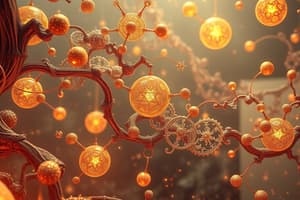Podcast
Questions and Answers
What is the molecular shape of NH3?
What is the molecular shape of NH3?
- Bent
- Trigonal Planar
- Pyramidal (correct)
- Tetrahedral
Which compound has a linear molecular shape?
Which compound has a linear molecular shape?
- NH3
- CO2 (correct)
- H2O
- BCl3
Which factor determines if a molecule is polar or nonpolar?
Which factor determines if a molecule is polar or nonpolar?
- Type of bonding
- Overall atomic mass
- Presence of lone pairs and shapes (correct)
- Molecular size alone
What is the polarity of CH3Br?
What is the polarity of CH3Br?
Which compound would you expect to have the highest boiling point?
Which compound would you expect to have the highest boiling point?
What type of structure does BF3 have?
What type of structure does BF3 have?
What enables ionic compounds to conduct electricity in water?
What enables ionic compounds to conduct electricity in water?
Which of the following correctly describes LDF and polarizability?
Which of the following correctly describes LDF and polarizability?
What is the primary factor that determines the strength of a covalent bond?
What is the primary factor that determines the strength of a covalent bond?
When drawing Lewis structures, what exception must be remembered regarding hydrogen?
When drawing Lewis structures, what exception must be remembered regarding hydrogen?
In which situation is it appropriate to use a double or triple bond when drawing Lewis structures?
In which situation is it appropriate to use a double or triple bond when drawing Lewis structures?
What is the purpose of calculating formal charge when assessing Lewis structures?
What is the purpose of calculating formal charge when assessing Lewis structures?
What should be ensured when drawing Lewis structures for more complex molecules like SF6?
What should be ensured when drawing Lewis structures for more complex molecules like SF6?
What is the fundamental first step in drawing a Lewis structure for a molecule?
What is the fundamental first step in drawing a Lewis structure for a molecule?
When arranging atoms in a Lewis structure, what is the priority for selecting a central atom?
When arranging atoms in a Lewis structure, what is the priority for selecting a central atom?
Which of the following correctly identifies a covalent compound's naming rule?
Which of the following correctly identifies a covalent compound's naming rule?
Flashcards
Covalent Bond
Covalent Bond
A bond formed when atoms share electrons.
Electronegativity
Electronegativity
A measure of an atom's ability to attract electrons in a bond.
Lewis Dot Structures
Lewis Dot Structures
Diagrams that show the bonding between atoms and the lone pairs of electrons.
Octet Rule
Octet Rule
Signup and view all the flashcards
Formal Charge
Formal Charge
Signup and view all the flashcards
Molecular Geometry
Molecular Geometry
Signup and view all the flashcards
Valence Electrons
Valence Electrons
Signup and view all the flashcards
Lewis Structure Exceptions
Lewis Structure Exceptions
Signup and view all the flashcards
NH3 Lewis Structure
NH3 Lewis Structure
Signup and view all the flashcards
BF3 Molecular Shape
BF3 Molecular Shape
Signup and view all the flashcards
Dipole Moment
Dipole Moment
Signup and view all the flashcards
Polar vs. Nonpolar Compounds
Polar vs. Nonpolar Compounds
Signup and view all the flashcards
Hydrogen Bonding
Hydrogen Bonding
Signup and view all the flashcards
Ionic Compounds Conductivity
Ionic Compounds Conductivity
Signup and view all the flashcards
C2H5OH Molecular Structure
C2H5OH Molecular Structure
Signup and view all the flashcards
Electron Configuration
Electron Configuration
Signup and view all the flashcards
Study Notes
Bonding Theory
- Bonding theory explores the different types of chemical bonds that hold atoms together.
- Two main types of bonds are ionic and covalent.
- Ionic bonds form between a metal and a nonmetal when electrons are transferred.
- Covalent bonds form between nonmetals when electrons are shared.
Covalent Bond
- In a covalent bond, the nuclei of the atoms repel each other, as do the electron clouds.
- The nucleus of each atom attracts both electron clouds.
- The attraction between the nuclei and the shared electron clouds forms a covalent bond.
- Electronegativity is an element's ability to attract bonding electrons in a chemical bond.
- Higher electronegativity values indicate a stronger attraction towards electrons.
Electronegativity
- Electronegativity trends across the periodic table.
- Electronegativity generally increases from left to right across a period and decreases down a group.
- The electronegativity scale goes from 0.0 to 4.0.
- Differences in electronegativity between atoms can affect the type of bond that forms.
- A difference in electronegativity can determine if a molecule is polar or non-polar.
Types of Covalent Bonds
- Non-polar covalent bond: Bonding electrons are equally shared between two atoms. No charges on atoms.
- Polar covalent bond: Bonding electrons are unequally shared between two atoms. Partial charges on atoms.
Naming Covalent Compounds
- Rule 1: Write the name of the 1st element, without a prefix.
- Rule 2: Write the name of the 2nd element, adding "-ide" to the end
- Rule 3: Use prefixes to tell the number of atoms of each element, using prefixes from the list below.
- Prefixes: mono-, di-, tri-, tetra-, penta-, hexa-, hepta-, octa-, nona-, and deca-
- Note: Mono is never used for the first element.
Lewis Dot Structures
- Lewis dot structures help represent how atoms bond.
- The diagrams illustrate the bonding arrangement of atoms with dots indicating valence electrons.
- Lewis dot structures often visually represent groups of elements such as group 14, 15, 16 and 17.
Octet Rule
- Elements tend to gain, lose, or share valence electrons to achieve a filled outermost electron shell (octet).
- A full outer energy level makes an atom stable.
- Helium has a full octet.
Formal Charge
- Formal charge (F.C.) helps decide the most likely Lewis structure.
- Choose a Lewis structure where atom formal charges are zero, or close to zero
- If there must be formal charges on an atom, the most electronegative atom should have the negative FC.
- Formal charge =Group number – (number of valence electrons–number of shared electrons – number of electrons in lone pairs)
VSEPR Theory
- Valence Shell Electron Pair Repulsion (VSEPR) theory explains molecular shapes.
- Electron pairs arrange themselves as far apart as possible.
- Electron domains (surrounding atoms and lone pairs) determine molecular geometry.
Molecular Models
- Specific shapes and colors denote different elements in molecular models
- Carbon (C): Black
- Hydrogen (H): Yellow
- Oxygen (O): Red
- Nitrogen (N): Blue
- Chlorine (Cl): Green
- Bromine (Br): Orange
- Iodine (I)/Fluorine (F): Purple
Intermolecular Forces
- Intramolecular forces are forces within a molecule.
- Intermolecular forces are forces between molecules, and can include various types of bonds (such as dipole-dipole forces and London dispersion forces).
- Dipole-dipole forces occur between polar molecules
- Hydrogen bonds are a special type of dipole-dipole force
Vapor Pressure
- Vapor pressure results when a lid is placed over a liquid container of molecules
- Molecules in the vapor phase collide with walls and cause a pressure.
- Evaporative rate = condensation rate
Ionic vs Covalent Compounds
- Compounds with metal and non metal elements usually have high melting and boiling points- ionic compounds
- Compounds of non metals usually have low melting and boiling points- covalent compounds
Types of Intermolecular Forces
- London Dispersion Forces (LDF): Temporary dipoles are formed because of fluctuations in electron movement. LDF is the only intermolecular force that operates between all types of molecules.
- Dipole-dipole forces: Forces occur between polar molecules.
- Hydrogen bonds: A special type of dipole-dipole force that occurs between molecules with hydrogen atoms bonded to highly electronegative atoms like N, O, or F.
Studying That Suits You
Use AI to generate personalized quizzes and flashcards to suit your learning preferences.



